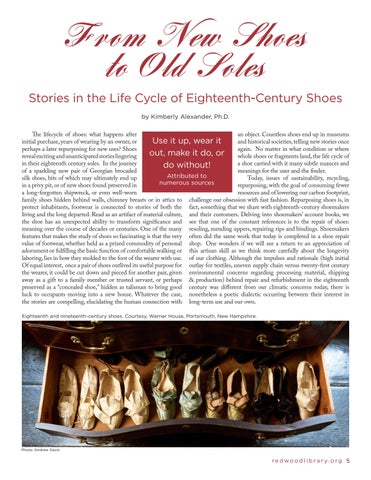From New Shoes to Old Soles Stories in the Life Cycle of Eighteenth-Century Shoes by Kimberly Alexander, Ph.D. an object. Countless shoes end up in museums The lifecycle of shoes: what happens after Use it up, wear it and historical societies, telling new stories once initial purchase, years of wearing by an owner, or again. No matter in what condition or where perhaps a later repurposing for new uses? Shoes out, make it do, or whole shoes or fragments land, the life cycle of reveal exciting and unanticipated stories lingering a shoe carried with it many subtle nuances and in their eighteenth century soles. In the journey do without! meanings for the user and the finder. of a sparkling new pair of Georgian brocaded Attributed to Today, issues of sustainability, recycling, silk shoes, bits of which may ultimately end up numerous sources repurposing, with the goal of consuming fewer in a privy pit, or of new shoes found preserved in resources and of lowering our carbon footprint, a long-forgotten shipwreck, or even well-worn family shoes hidden behind walls, chimney breasts or in attics to challenge our obsession with fast fashion. Repurposing shoes is, in protect inhabitants, footwear is connected to stories of both the fact, something that we share with eighteenth-century shoemakers living and the long departed. Read as an artifact of material culture, and their customers. Delving into shoemakers’ account books, we the shoe has an unexpected ability to transform significance and see that one of the constant references is to the repair of shoes: meaning over the course of decades or centuries. One of the many resoling, mending uppers, repairing rips and bindings. Shoemakers features that makes the study of shoes so fascinating is that the very often did the same work that today is completed in a shoe repair value of footwear, whether held as a prized commodity of personal shop. One wonders if we will see a return to an appreciation of adornment or fulfilling the basic function of comfortable walking or this artisan skill as we think more carefully about the longevity laboring, lies in how they molded to the foot of the wearer with use. of our clothing. Although the impulses and rationale (high initial Of equal interest, once a pair of shoes outlived its useful purpose for outlay for textiles, uneven supply chain versus twenty-first century the wearer, it could be cut down and pieced for another pair, given environmental concerns regarding processing material, shipping away as a gift to a family member or trusted servant, or perhaps & production) behind repair and refurbishment in the eighteenth preserved as a “concealed shoe,” hidden as talisman to bring good century was different from our climatic concerns today, there is luck to occupants moving into a new house. Whatever the case, nonetheless a poetic dialectic occurring between their interest in the stories are compelling, elucidating the human connection with long-term use and our own. Eighteenth and nineteenth-century shoes. Courtesy, Warner House, Portsmouth, New Hampshire.
Photo: Andrew Davis
r e d w o o d l i b r a r y. o r g 5







